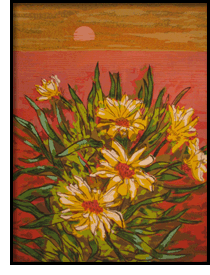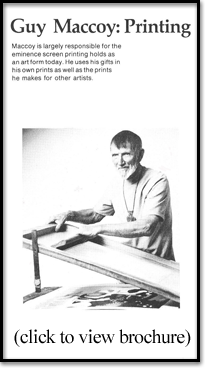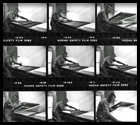|


The following definitions are taken from one of Guy Maccoy's brochures from the 1960s.
 History of the Silk Screen
History of the Silk Screen
The origin of the stencil has been attributed to the Chinese and Egyptians. The earliest antecedents of our present-day silk-screen methods came from the stencil makers of ancient Japan, who laquered paper stencils onto crisscrossed hairs. Later, toward the end of the last (19th) century in Europe, early prototypes of the modern silk screen process were used to produce playing cards. For the past 60 years, the process has been widely used for printing signs, textiles, etc. At first, the technical secrets were closely held, but nowadays there are many books on the subject.
Origin of the Serigraph
In 1930, Guy Maccoy and his wife Geno Pettit accepted a commercial art job as a means of subsidizing their more creative efforts. When the job was done, they had a great deal of silk screen materials left over. The New York galleries around this time were importing "pochoir" prints from France, which also involve the use of the stencil principle - and this gave them the idea of trying to make original vreative prints on the silk screen.
Thus in 1932, Mr. Maccoy made the first of two serigraphs, "Woman Holding a Cat" and "Still Life". However, he was forced to abandon further efforts because of the poor quality of the paint. A few years later, he tried a watercolor medium, and in 1938, held the first one-man show of original serigraphs at the Contemporary Art Gallery in New York.
Soon after this, artists on the Federal Art Project developed a more satisfactory oil medium, and then serigraphy spread out from New York, carried to Los Angeles by the Maccoys, and is now being practiced by many artists all over the country.
 The Meaning
The Meaning
The word serigraph derives from "seri" (Greek for silk) and "graph" (to draw). This term is copyrighted. This copyright protects the artist who produces his own limited edition of original serigraphs.
The Technique

|

|
Click thumbnails to see Guy demonstrate, step-by-step, the serigraph process.
The basic equipment is a length of silk stretched taut upon the bars of a frame, much in the manner of a canvas on stretchers. The untreated silk is porous. Areas that are opened by the use of a tusche (a black waxy ink) or simply left open when applying the glue, become the printing areas. The hinged screen is brought down flat upon the printing paper registered beneath. An oil paint is squeezed through these open areas by means of a rubber squeegee, the layer of paint remaining on the paper when the screen is lifted. Each print in turn is then hung up to dry.
When a turn is finished, the screen is cleansed with a paint solvent, and the glue stencil washed away with water. A new stencil is then prepared for each subsequent color run. In this way layer upon layer - as many as ten or twenty or more - of transparent or opaque colors can be superimposed over each other until the desired effect is achieved.
Click Here to read an article by Frederic Whitaker for a more thorough explanation of the process.
Guy Maccoy Show Brochure
Click each thumbnail to see bigger versions
Serigraph Gallery
Click Here to view a gallery of Guy Maccoy's serigraphs, many of which are available for purchase.
Top
| Back
| Home
   
|










